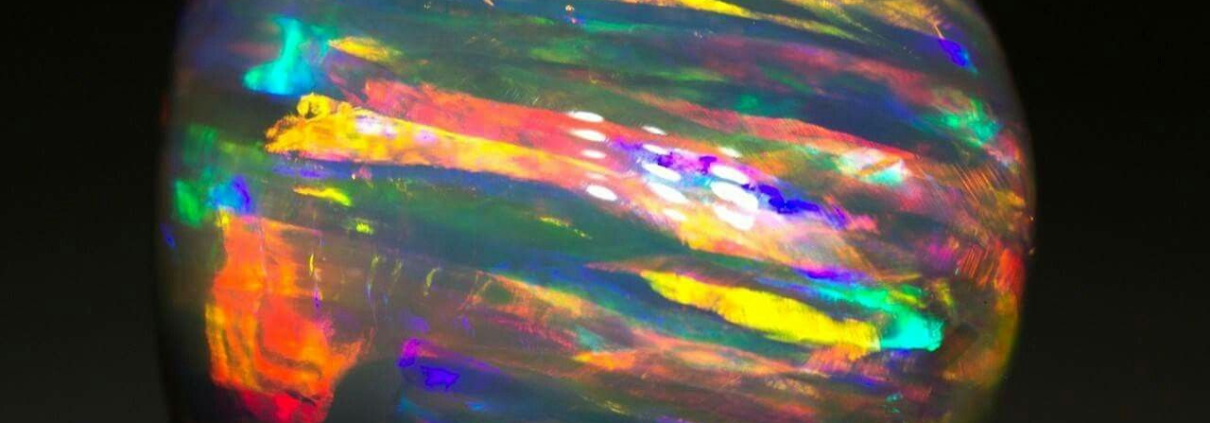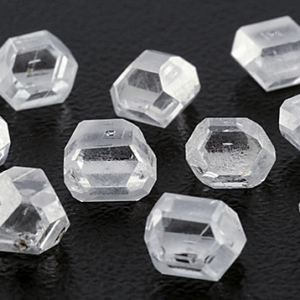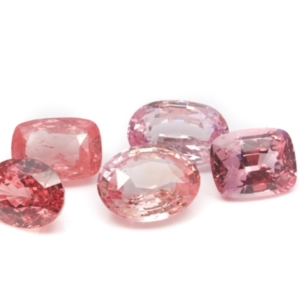Rainbow Opals
Rainbow opals are gemstones renowned for their captivating play of colors, making them highly prized in the world of gemology and jewelry. These opals exhibit a stunning array of hues that seem to dance and shift as the gemstone is viewed from different angles. This optical phenomenon, known as play of color, occurs due to the diffraction of light within the microstructure of the opal, which consists of tiny silica spheres stacked in a regular pattern.
 The Most Beautiful Opal in the World – The Rainbow Opal (calderagem.com)
The Most Beautiful Opal in the World – The Rainbow Opal (calderagem.com)
Rainbow opals belong to the broader category of precious opals, distinguished by their ability to display iridescent colors. This unique feature arises from the silica spheres that diffract light, causing a spectrum of colors to emerge across the gem’s surface. The most sought-after opals exhibit a full spectrum of colors, including red, orange, yellow, green, blue, indigo, and violet, often in mesmerizing patterns. These gemstones are valued not only for their aesthetic appeal but also for their rarity and the intricate geological processes that create them.
Historical Significance
Rainbow opals have significant historical and cultural importance, particularly among indigenous Australian communities where opals have been revered for millennia. The Aboriginal people of Australia, for instance, considered opals as sacred stones that were believed to contain the essence of the creator’s rainbow. Throughout history, opals have been associated with hope, purity, and good fortune in various cultures around the world. Their popularity surged during the 19th century when Queen Victoria developed a fondness for opals, further elevating their status and desirability in Europe.
In summary, rainbow opals are not only cherished for their visual splendor but also for their rich cultural heritage and symbolic meanings. Their ability to encapsulate the colors of the rainbow within a single gemstone continues to captivate gem enthusiasts and collectors alike, ensuring their enduring appeal in the realm of precious gemstones.
Contents
- Types of Rainbow Opals
- Geological Formation of Rainbow Opals
- Physical Properties of Rainbow Opals
- Cultural and Symbolic Meaning of Rainbow Opals
Types of Rainbow Opals

Rainbow opals come in various types, distinguished by their origin and characteristics, including natural and synthetic varieties. Here’s an overview of the different types:
Natural Rainbow Opals: Natural rainbow opals are formed through natural geological processes over millions of years. They are mined from opal deposits around the world, with notable sources including Australia, Ethiopia, Mexico, and Brazil. These opals exhibit a unique play of color, which is the result of light diffracting through the silica spheres within the gemstone. Natural rainbow opals are highly valued for their rarity, quality of color, and the natural processes that create their stunning visual effects.
Synthetic Rainbow Opals: Synthetic rainbow opals are created in laboratories using processes that mimic the natural formation of opals. These synthetic gems are engineered to replicate the play of color found in natural opals by arranging silica spheres in a controlled environment. While synthetic opals can be more affordable and have a consistent appearance, they lack the geological authenticity and rarity of natural opals.

Common Varieties of Rainbow Opals:
- Black Opals: Known for their dark body tone that enhances the vividness of their play of color. Black opals are primarily mined in Lightning Ridge, Australia.
- White Opals: Characterized by a light or white body tone, these opals display a bright play of color against their background. They are found in various Australian opal fields.
- Boulder Opals: These opals are found embedded in ironstone boulders, often displaying a natural matrix that enhances their aesthetic appeal. Boulder opals are primarily sourced from Queensland, Australia.
- Crystal Opals: Crystal opals are transparent to semi-transparent with a vibrant play of color that can appear over a clear or slightly translucent background. They are prized for their clarity and intense colors.
Each variety of rainbow opal offers unique characteristics and appeals to collectors and enthusiasts for their distinct beauty and rarity in the world of gemstones.
Geological Formation of Rainbow Opals

Rainbow opals are formed through a complex geological process involving the interaction of water with silica-rich materials. Here’s an overview of the natural conditions for their formation and locations of significant deposits:
Natural Conditions for Formation:
- Geological Setting: Rainbow opals typically form in regions where silica-bearing solutions seep into cavities or fissures in sedimentary rocks, such as sandstone or claystone. These solutions contain dissolved silica (silicon dioxide) along with water and other trace elements.
- Formation Process: The formation begins with the deposition of silica-rich gel in the fissures or voids. Over time, this gel hardens and solidifies into opal through a process known as opalization. The formation of rainbow opals depends on the presence of orderly arrays of silica spheres within the opal structure, which diffract light to produce the play of color.
- Environmental Factors: The presence of groundwater and specific geological conditions, such as the right temperature, pressure, and chemical composition, are crucial for opal formation. These conditions influence the color, clarity, and overall quality of the opal.
Locations of Significant Deposits:
- Australia: Australia is the world’s primary source of opals, including rainbow opals. Notable opal fields in Australia include:
- Lightning Ridge: Known for black opals, some of the most valuable and vibrant rainbow opals are found here.
- Coober Pedy: Famous for white opals, which exhibit a lighter body tone with striking play of color.
- Queensland (e.g., Winton, Quilpie): Home to boulder opals, which form in ironstone boulders with opalized veins.
- Ethiopia: Significant deposits of rainbow opals have been discovered in Ethiopia, particularly in the Wollo Province. Ethiopian opals, known for their bright play of color, have gained popularity in recent years.
- Mexico: Rainbow opals are also found in Mexico, primarily in the state of Jalisco. Mexican opals often exhibit a fiery play of color against a translucent to opaque background.
- Brazil: Opals, including rainbow opals, are mined in various regions of Brazil, such as Minas Gerais. Brazilian opals are known for their variety in colors and patterns.
These locations are characterized by specific geological formations and conditions that favor the formation of opals with unique play of color. The diversity in opal types and locations contributes to their appeal and value in the gemstone market.
Physical Properties of Rainbow Opals

Rainbow opals possess distinct physical properties that contribute to their unique appearance and value in the world of gemstones. Here are key aspects of their physical properties:
Color Play (Iridescence):
- The most distinctive feature of rainbow opals is their play of color, also known as iridescence. This phenomenon occurs due to the diffraction of light as it passes through the microscopic silica spheres that make up the opal’s structure.
- The silica spheres are arranged in a regular pattern, which causes incoming light to separate into its component colors. This results in a vibrant spectrum of hues that appear to shift and shimmer as the opal is viewed from different angles.
- The colors displayed can include red, orange, yellow, green, blue, indigo, and violet, often in intricate patterns known as “pinfire,” “harlequin,” or “chaff.”
Composition and Structure:
- Chemical Composition: Rainbow opals are primarily composed of hydrated silica (silicon dioxide, SiO2 · nH2O). They may also contain trace elements such as iron and carbon, which can influence their coloration and opacity.
- Microstructure: The play of color in rainbow opals is due to their unique internal structure. The opal consists of tiny silica spheres (typically 150 to 300 nanometers in diameter) that are stacked in a three-dimensional grid-like pattern.
- Formation: These silica spheres form as a gel-like substance solidifies within cracks or voids in rock formations over millions of years. The orderly arrangement of these spheres is critical for the diffraction of light and the resulting iridescence.
- Physical Properties: Rainbow opals are generally amorphous (lacking a crystal structure) and have a hardness ranging from 5.5 to 6.5 on the Mohs scale. This hardness makes them relatively soft compared to other gemstones like diamonds or sapphires, requiring careful handling and protection from scratches.
Cultural and Symbolic Meaning of Rainbow Opals

Rainbow opals have held significant cultural and symbolic meanings across various civilizations throughout history:
- Aboriginal Australian Culture: In Australian Aboriginal culture, opals, including rainbow opals, are considered sacred stones that carry spiritual significance. They are believed to embody the creator’s rainbow and are associated with hope, purity, and healing. Opals have been used in ceremonies and rituals to connect with the spiritual realm and promote harmony.
- European and Western Culture: In Europe, opals gained popularity during the 19th century when Queen Victoria developed a fondness for them. Opals were believed to bring good fortune and were worn as protective talismans. However, there was also a superstition that opals brought bad luck to those not born in October, the opal’s birthstone month.
- Modern Symbolism: Today, rainbow opals are often associated with creativity, inspiration, and emotional healing. They are valued not only for their aesthetic beauty but also for their ability to promote a sense of optimism and positivity.
Mining and Extraction of Rainbow Opals
- Locations: Rainbow opals are primarily mined in regions known for opal deposits, such as Australia, Ethiopia, Mexico, and Brazil. Each region produces opals with unique characteristics and colors, reflecting the geological conditions of their formation.
- Mining Techniques: Opal mining techniques vary depending on the location and geological setting. In Australia, for example, mining methods range from traditional shaft sinking and tunnelling to modern open-cut mining and hydraulic extraction. Miners often work in small-scale operations, especially in areas like Lightning Ridge and Coober Pedy.
- Challenges: Mining rainbow opals can be challenging due to the fragile nature of the gemstone and the specific geological conditions required for their formation. Extraction methods must be carefully chosen to minimize damage to the opals and ensure sustainable practices.

Market and Pricing of Rainbow Opals
- Market Demand: Rainbow opals are highly sought after in the gemstone market for their unique play of color and rarity. They appeal to collectors, jewelry designers, and enthusiasts looking for distinctive gemstones that stand out.
- Factors Affecting Pricing: The pricing of rainbow opals is influenced by several factors:
- Play of Color: Opals with vibrant and distinct play of color command higher prices.
- Size and Carat Weight: Larger opals are rarer and more valuable, especially if they exhibit high-quality color play.
- Origin: Opals from renowned mining regions like Lightning Ridge in Australia or new discoveries in Ethiopia may fetch premium prices.
- Clarity and Transparency: Crystal opals and opals with clearer body tones are often more valuable due to their transparency and brightness.
- Market Trends: The market for rainbow opals can fluctuate based on trends in jewelry design, fashion, and cultural preferences. Demand may also be influenced by economic factors and changes in consumer preferences.
Overall, rainbow opals hold both cultural significance and commercial value, making them prized gemstones in the global marketplace.



Leave a Reply
Want to join the discussion?Feel free to contribute!